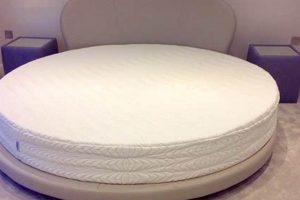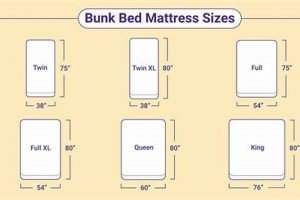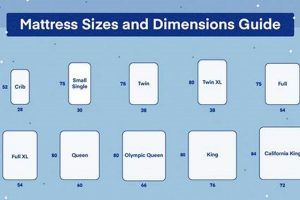Sleeping arrangements within recreational vehicles frequently involve specialized sleeping surfaces designed to maximize comfort within limited spaces. These sleeping platforms are manufactured in diverse sizes and constructions to accommodate various vehicle layouts and user preferences. Dimensions, materials, and overall thickness are key characteristics that differentiate these from residential counterparts.
The selection of an appropriate sleeping surface for these vehicles directly impacts the overall travel experience. A supportive and comfortable option promotes restorative sleep, mitigating fatigue associated with travel. Historical context reveals a shift from basic, utilitarian designs towards advanced materials and ergonomic considerations, mirroring advancements in residential sleep technology. The benefits extend beyond mere comfort; a properly chosen surface can contribute to improved posture and reduced pressure points, crucial for extended journeys.
The following sections will delve into specific types, common sizing considerations, factors influencing purchasing decisions, and proper maintenance techniques related to these RV sleeping solutions. This will provide a complete understanding of how to make informed choices and ensure the longevity of the selected product.
Essential Considerations for RV Sleeping Surfaces
Selecting the optimal sleeping surface for a recreational vehicle requires careful evaluation of multiple factors to ensure both comfort and durability. These considerations extend beyond those typically associated with residential sleeping solutions due to the unique environment within an RV.
Tip 1: Measure the Available Space Accurately: Precise measurements of the sleeping area are crucial prior to purchase. Standard residential sizes rarely correspond directly to RV dimensions. Ensure sufficient clearance for movement and accessibility around the bed.
Tip 2: Evaluate Material Composition: Consider the climate in which the RV will be used. Memory foam retains heat, potentially causing discomfort in warmer environments. Latex or innerspring options may offer better breathability and temperature regulation.
Tip 3: Assess Weight Restrictions: Recreational vehicles have defined weight limits. Opt for lighter materials to minimize the impact on overall vehicle weight and fuel efficiency. Research the density of different materials and their corresponding weight per square foot.
Tip 4: Prioritize Support and Firmness: A supportive sleeping surface is essential for preventing back pain and promoting proper spinal alignment. Individual preferences for firmness vary, but a medium-firm option typically provides a balance of comfort and support.
Tip 5: Investigate Durability and Longevity: RV sleeping surfaces are subjected to frequent use and potential temperature fluctuations. Choose materials known for their durability and resistance to wear and tear. Consider options with removable and washable covers to facilitate cleaning and maintenance.
Tip 6: Consider Customization Options: Many manufacturers offer custom sizes and shapes to accommodate unique RV layouts. Exploring customization options can maximize space utilization and optimize comfort.
Understanding these crucial considerations enables a well-informed purchase decision, leading to enhanced comfort and prolonged product lifespan. Investing time in careful evaluation will ultimately contribute to a more enjoyable and restful RV travel experience.
The subsequent section will explore specific brands and models commonly available, providing a practical guide to navigating the market.
1. Dimensions and Size
The dimensions and size of an RV bed mattress are paramount considerations, directly influencing both comfort and functionality within the limited confines of a recreational vehicle. Unlike standard residential mattresses, RV mattress sizes are often non-standard and vary significantly depending on the vehicle’s make, model, and floor plan. Incorrect dimensions can result in a mattress that is too large, obstructing movement within the RV, or too small, leaving uncomfortable gaps and wasted space. Precise measurement of the available sleeping area is therefore crucial.
The available space often dictates whether a standard RV mattress size, such as a short queen (60″ x 75″), a full (53″ x 75″), or a twin (38″ x 75″), is appropriate. However, custom sizes are frequently required due to unconventional bedroom layouts. The effect of selecting the wrong size extends beyond mere inconvenience. An ill-fitting mattress may prevent proper closure of slide-outs or access to storage compartments. Furthermore, inadequate support along the edges of an undersized mattress can lead to premature wear and tear. For instance, if an RV bed frame is designed for a 60″ x 80″ queen, and a 60″ x 75″ short queen is installed, the unsupported edges will sag over time, diminishing the mattress’s lifespan and comfort.
In summary, the direct correlation between dimensions, size, and the appropriateness of an RV bed mattress necessitates meticulous attention to detail. Oversights in measurement and size selection can lead to discomfort, compromised space utilization, and accelerated product degradation. Understanding this connection is fundamental for optimizing the sleep experience within the unique constraints of an RV environment. Accurately matching the mattress dimensions to the available space ensures not only comfort but also the long-term functionality and preservation of the sleeping area.
2. Material Composition
Material composition is a critical determinant of the performance and suitability of a recreational vehicle (RV) bed mattress. The materials used directly influence comfort, durability, weight, and temperature regulation, all of which are paramount in the confined and often fluctuating environment of an RV.
- Foam Density and Type
Foam, commonly polyurethane or memory foam, forms the core of many RV mattresses. Density, measured in pounds per cubic foot, affects both support and longevity. Higher density foams offer greater support and resistance to compression over time, while lower density foams tend to be less expensive but may degrade more rapidly. Memory foam, known for its conforming properties, can trap heat, a significant consideration in warmer climates. The choice between conventional polyurethane foam and memory foam depends on balancing comfort preferences with environmental factors.
- Innerspring Coil Design and Gauge
Innerspring mattresses, though less common in RVs due to weight, offer a traditional feel and potentially better ventilation. The coil design, whether Bonnell, offset, or pocketed, influences motion transfer and overall support. The gauge, or thickness, of the wire used for the coils determines firmness and durability. Lower gauge numb
ers indicate thicker, stronger coils. A well-constructed innerspring mattress can provide robust support, but its weight must be carefully considered to avoid exceeding the RV’s load capacity. - Cover Fabric Properties
The fabric used for the mattress cover plays a vital role in breathability, moisture wicking, and hygiene. Natural fibers like cotton promote airflow and are less prone to causing skin irritation. Synthetic fabrics, such as polyester blends, offer enhanced durability and stain resistance. Antimicrobial treatments may be applied to the fabric to inhibit bacterial growth, a beneficial feature in the often humid environment of an RV. The cover’s construction, including quilting patterns and seams, also contributes to overall comfort and resistance to wear and tear.
- Latex Composition (Natural vs. Synthetic)
Latex, available in both natural and synthetic forms, offers a balance of comfort, support, and breathability. Natural latex, derived from rubber trees, is hypoallergenic and resistant to dust mites, making it a suitable choice for individuals with allergies. Synthetic latex, often made from styrene-butadiene rubber (SBR), is less expensive but may lack the same durability and hypoallergenic properties. The manufacturing process, whether Dunlop or Talalay, also influences the latex’s density and feel. Latex mattresses generally offer excellent pressure relief and temperature regulation, making them a premium option for RV sleeping solutions.
In conclusion, the material composition of an RV bed mattress directly impacts its ability to provide adequate support, comfort, and longevity within the unique constraints of recreational vehicle living. Understanding the properties of different materials, from foam density to cover fabric, is essential for making an informed purchasing decision that aligns with individual needs and the specific demands of the RV environment. Factors such as climate, weight restrictions, and personal preferences must be carefully considered when evaluating the various material options available.
3. Weight and Density
The weight and density of a recreational vehicle bed mattress are critical factors directly impacting both the vehicle’s overall performance and the comfort experienced by its occupants. The mass added by the sleeping surface contributes to the total weight of the RV, influencing fuel efficiency, handling characteristics, and potentially exceeding permissible weight limits defined by the manufacturer or regulatory bodies. Density, a measure of mass per unit volume, indicates the compactness of the materials used within the mattress and has implications for support, durability, and temperature regulation. Exceeding weight limits can compromise structural integrity, increase the risk of tire failure, and diminish braking effectiveness.
A higher-density mattress, typically constructed with denser foams or more tightly packed innersprings, provides greater support and is less likely to sag or compress prematurely. However, increased density invariably translates to increased weight. A latex mattress, for example, might offer superior pressure relief and durability compared to a low-density polyurethane foam mattress, but it will also weigh significantly more. Conversely, a lightweight, low-density mattress might alleviate weight concerns but may sacrifice long-term comfort and support. Consider a scenario where replacing a standard innerspring RV mattress with a high-density memory foam option increases the vehicle’s overall weight by several hundred pounds. This additional weight could reduce fuel economy by a measurable percentage, especially during extended travel, and potentially necessitate adjustments to the RV’s suspension system.
In conclusion, the interplay between weight and density in the context of RV bed mattresses necessitates a carefully considered compromise. Prioritizing lightweight materials can mitigate the negative effects on fuel efficiency and vehicle handling, but it may compromise the long-term comfort and support provided by the sleeping surface. Selecting a mattress requires a thorough understanding of the vehicle’s weight limitations, anticipated travel conditions, and individual comfort preferences to strike an optimal balance. Ignoring this balance can result in diminished vehicle performance, accelerated component wear, and a compromised sleep experience.
4. Support and Firmness
Support and firmness are fundamental characteristics of an RV bed mattress that directly influence sleep quality and physical well-being during travel. Support refers to the mattress’s ability to maintain proper spinal alignment and distribute weight evenly, preventing pressure points and minimizing discomfort. Firmness, on the other hand, is a subjective measure of how hard or soft the mattress feels to the user. The interplay between these two elements is critical in determining the overall suitability of a sleeping surface, particularly within the confines of a recreational vehicle where space is limited and prolonged periods of rest may be necessary. Insufficient support can lead to back pain, muscle stiffness, and exacerbated discomfort from existing spinal conditions. Conversely, a mattress that is too firm may create pressure points, hindering circulation and resulting in restless sleep. For instance, an individual with a history of sciatica may find a mattress lacking in proper support aggravates their condition, leading to increased pain and reduced mobility during their travels. The selection of appropriate support and firmness levels, therefore, directly contributes to the overall health and comfort of RV occupants.
Consider the practical application of this understanding in the context of long-distance RV travel. Extended periods spent driving can place considerable strain on the body, making restorative sleep even more crucial. A well-chosen RV bed mattress, designed with appropriate support and firmness characteristics, can mitigate the effects of travel fatigue and promote more restful sleep. For example, a couple sharing an RV bed may have differing preferences regarding firmness levels. In such cases, a mattress with zoned support, featuring varying levels of firmness in different areas, can provide a customized sleep experience for each individual, optimizing comfort and minimizing disturbances. Furthermore, the material composition of the mattress, such as memory foam or latex, significantly impacts both support and firmness. Memory foam conforms to the body’s contours, providing excellent pressure relief and support, while latex offers a more resilient and responsive feel, suitable for individuals who prefer a firmer sleeping surface.
In conclusion, the selection of an RV bed mattress necessitates careful consideration of both support and firmness characteristics. The optimal balance between these elements depends on individual preferences, physical conditions, and the demands of RV travel. Challenges may arise in finding a mattress that accommodates the diverse needs of multiple occupants or that provides adequate support within the limited space and weight constraints of the vehicle. However, by prioritizing these factors and understanding their impact on sleep quality and physical well-being, RV travelers can significantly enhance their overall travel experience and mitigate the potential negative effects of prolonged periods on the road. A thorough understanding of the connection between support, firmness, an
d the unique requirements of RV travel is therefore essential for making informed purchasing decisions.
5. Durability and Longevity
The durability and longevity of an RV bed mattress are critical attributes influencing its overall value and long-term suitability for use within the demanding environment of recreational vehicle travel. These characteristics dictate the mattress’s ability to withstand frequent use, temperature fluctuations, and the inherent stresses associated with mobile living. Premature degradation necessitates replacement, incurring additional costs and disrupting travel plans. Therefore, understanding the factors contributing to a mattress’s durability and potential lifespan is essential for making an informed purchasing decision.
- Material Degradation Resistance
The resistance of mattress materials to degradation, such as foam compression, fabric wear, and structural breakdown, significantly impacts its lifespan. Exposure to UV radiation, temperature extremes, and humidity can accelerate material deterioration. Higher quality materials, designed with inherent resistance to these environmental factors, contribute to greater durability. For instance, latex mattresses, known for their resilience, typically outlast polyurethane foam options in similar usage conditions. The implications are straightforward: a mattress with poor material degradation resistance will require more frequent replacement, diminishing its long-term economic value.
- Construction Integrity and Build Quality
The manner in which the mattress is constructed directly affects its ability to withstand repeated use and potential stresses from travel. Reinforced seams, durable stitching, and a robust core structure contribute to overall integrity. Mattresses assembled with substandard techniques or low-quality adhesives are prone to premature failure, such as seam separation or internal shifting of materials. A mattress constructed with meticulous attention to detail and employing high-quality assembly methods demonstrates greater resistance to wear and tear, ultimately extending its usable life.
- Resistance to Mold and Mildew
The confined spaces within RVs often exhibit elevated humidity levels, creating an environment conducive to mold and mildew growth. Mattresses constructed with breathable materials and antimicrobial treatments are better equipped to resist the proliferation of these organisms. Mold and mildew not only compromise the mattress’s structural integrity but also pose potential health risks to occupants. A mattress with inherent resistance to these biological agents maintains its hygienic properties and prolongs its usability in humid conditions.
- Maintenance and Care Influence
The lifespan of an RV bed mattress is directly influenced by the level of maintenance and care it receives. Regular cleaning, proper ventilation, and the use of protective mattress covers can significantly extend its usable life. Neglecting these maintenance practices accelerates material degradation and increases the risk of mold and mildew growth. For example, routinely vacuuming the mattress surface and allowing it to air out can prevent the accumulation of dust and moisture, preserving its integrity and prolonging its lifespan. Therefore, proactive maintenance habits are crucial for maximizing the durability and longevity of an RV mattress.
In summary, the durability and longevity of an RV bed mattress are determined by a confluence of factors, including material degradation resistance, construction integrity, resistance to mold and mildew, and the extent of maintenance performed. Understanding these interconnected elements is essential for making a well-informed purchase and ensuring that the chosen mattress provides long-term comfort and value within the unique environment of recreational vehicle travel. Investing in a mattress with robust construction and implementing diligent maintenance practices mitigates the risk of premature failure, ultimately maximizing its usable life and contributing to a more enjoyable travel experience.
Frequently Asked Questions
This section addresses common inquiries and misconceptions regarding RV bed mattresses, providing factual information to guide informed decision-making.
Question 1: What distinguishes an RV bed mattress from a standard residential mattress?
RV bed mattresses frequently exhibit non-standard dimensions to accommodate the spatial constraints of recreational vehicles. Furthermore, weight considerations often necessitate the use of lighter materials compared to those found in standard residential mattresses.
Question 2: How does the weight of an RV bed mattress impact fuel efficiency?
Increased weight contributes directly to decreased fuel efficiency. Selecting a lighter mattress minimizes the overall weight of the recreational vehicle, thereby reducing fuel consumption during travel.
Question 3: What level of firmness is optimal for an RV bed mattress?
Optimal firmness is subjective and dependent on individual preferences. However, a medium-firm mattress generally provides a balance of support and comfort suitable for a wide range of users. Individuals with specific medical conditions should consult with a healthcare professional.
Question 4: How frequently should an RV bed mattress be replaced?
The lifespan of an RV bed mattress varies based on material quality, usage frequency, and maintenance practices. A general guideline suggests replacement every five to ten years, or sooner if signs of wear, sagging, or discomfort become apparent.
Question 5: Is it possible to customize the size of an RV bed mattress?
Many manufacturers offer customization options to accommodate the unique dimensions of RV sleeping areas. This may involve specifying custom lengths, widths, or shapes to ensure a proper fit.
Question 6: How can mold and mildew growth be prevented in an RV bed mattress?
Maintaining proper ventilation, using a breathable mattress cover, and periodically airing out the mattress can help prevent mold and mildew growth. Additionally, selecting a mattress with antimicrobial properties can provide added protection.
Key takeaways include the importance of considering size, weight, firmness, and material composition when selecting an RV bed mattress. Regular maintenance and timely replacement are crucial for ensuring long-term comfort and hygiene.
The subsequent section will provide practical advice on selecting the appropriate RV bed mattress, consolidating the information presented in previous sections.
RV Bed Mattress
This exploration has emphasized the multifaceted nature of the rv bed mattress, extending beyond mere comfort to encompass critical factors such as dimensions, material composition, weight, support, durability, and maintenance. The optimal choice necessitates a thorough understanding of individual needs and the specific constraints of recreational vehicle travel. Compromises may be required, balancing comfort with space limitations and weight restrictions. Careful evaluation of available options, guided by the principles outlined herein, is paramount.
The selection of an rv bed mattress is an investment in long-term well-being during travel. Prioritizing both comfort and practicality, informed by rigorous research, will yield a superior sleep experience and contrib
ute to enhanced travel enjoyment. Future advancements in materials science and ergonomic design promise continued improvements in rv bed mattress technology, further optimizing comfort and durability for recreational vehicle users.


![Best Split Mattress Beds: Reviews & Guide [Year] Organic & Natural Mattress Buyer’s Guide: Non-Toxic Sleep Solutions Best Split Mattress Beds: Reviews & Guide [Year] | Organic & Natural Mattress Buyer’s Guide: Non-Toxic Sleep Solutions](https://mattressworldpa.com/wp-content/uploads/2025/07/th-7152-300x200.jpg)
![[Protect Bed!] Bed Bath & Beyond Mattress Covers - Deals Organic & Natural Mattress Buyer’s Guide: Non-Toxic Sleep Solutions [Protect Bed!] Bed Bath & Beyond Mattress Covers - Deals | Organic & Natural Mattress Buyer’s Guide: Non-Toxic Sleep Solutions](https://mattressworldpa.com/wp-content/uploads/2025/07/th-7151-300x200.jpg)



